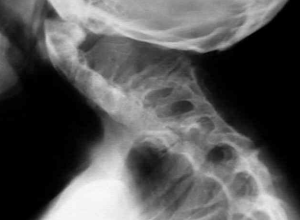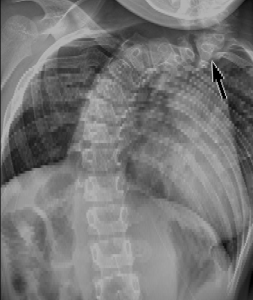Klippel-Feil syndrome is an uncommon condition that is present from birth and which features the fusion of any two of the seven cervical vertebrae. It can be said that Klippel-Feil syndrome is present in a heterogeneous bunch of individuals, who are united only by the prevalence of a congenital abnormality in the segmentation or development of the cervical spine. The condition was first described by Maurice Klippel and André Feil from France, in 1912.
Klippel-Feil syndrome is present in a number of forms and most of the cases go undiagnosed. Hence, it is not possible to estimate the occurrence rate of the disease. Additionally, the form of inheritance also varies from one affected individual to another.
Symptoms of Klippel-Feil syndrome
Klippel-Feil syndrome may result in a number of signs and symptoms. The symptoms may be detected at birth or much later in life. Klippel-Feil syndrome may be associated with another condition called fetal alcohol syndrome.
Some of the symptoms of Klippel-Feil syndrome are discussed below:
- One of the primary symptoms of Klippel-Feil syndrome is the marked decrease in the range of motion of the neck. The loss of rotation is greater as compared to that experienced in neck extension and flexion
- The upper part of the cervical spine may experience abnormalities at an earlier stage as compared to those experienced by the lower part of the cervical spine
- Some patients suffer from cardiovascular abnormalities, especially ventricular septal defect
- Around forty to fifty percent of the individuals affected by Klippel-Feil syndrome have a low hairline
- Synkinesia is the parallel motion of the upper parts in which an individual with Klippel-Feil syndrome is unable to carry out a movement of the left hand without carrying out a similar movement with the right hand. This can be very debilitating for the affected patient. This symptom generally tends to improve as one grows older. Physical therapy also helps.
- Around 20 percent of the patients may experience neurological abnormalities due to the presence of hypermobility. A few individuals may experience pain. In about 60 percent of the cases, spine curvature anomalies like scoliosis may be present from birth or develop later. On occasions, compensatory scoliosis may be present. There may be acute compression of the spinal cord due to severe cervical anomalies caused due to minor injury or trauma.
- Some conditions that may accompany Klippel-Feil syndrome include kidney and rib disorders, respiratory difficulties, spina bifida, cleft palate and cardiac malformations. Additionally, abnormalities of the genitals, legs, arms and fingers, face and head, muscles, skeleton, and the spinal cord and brain may also be present.
- Presence of ear anomalies can result in conductive, sensory-neural or mixed hearing loss. Majority of such individuals with ear defects may eventually become deaf
- Around 25 to 50 percent of the individuals with Klippel-Feil syndrome may experience asymmetry of the face and Torticollis along with possible craniofacial abnormalities
- Some patients may suffer from different and many anomalies of the renal system
Types of Klippel-Feil syndrome
Klippel-Feil syndrome is classified into three types as per the fusion of cervical vertebrae. They are as follows:
- Type I indicates extreme fusion of several upper thoracic and cervical vertebrae to form bony blocks
- Type II indicates the presence of fusion at only 1 or 2 interspaces. However, occipito-atlantal, hemivertebrae fusion and other abnormalities may also develop
- Type III indicates the presence of both cervical fusion and lumbar or lower thoracic fusion
There is another different classification of Klippel-Feil syndrome, discussed below:
- Type I indicates the presence of a single fused cervical segment, prevalent from birth
- Type II indicates the presence of multiple, noncontiguous, fused segments prevalent from birth.
- Type III indicates the presence of multiple contiguous, fused cervical segments prevalent from birth.
Causes of Klippel-Feil syndrome
Klippel-Feil syndrome is caused due to mutations of the GDF3 and GDF6 genes present in the long arm of chromosome 8. Mutations of the above listed genes may not occur in a few individuals affected by Klippel-Feil syndrome. In such cases, the cause of the disease is unknown.
The GDF3 and GDF6 genes play an important role in the production of certain proteins that perform the function of controlling the maturation and growth of cartilage and bone. Mutations of the genes result in decreased production of the protein which results in the abnormal symptoms associated with Klippel-Feil syndrome.
The gene mutations can be inherited in the following ways:
- Through an autosomal recessive pattern of inheritance, wherein both copies of the gene have to be altered to cause the condition. It is especially accompanied by C5-C6 fusion
- Through an autosomal dominant pattern of inheritance, wherein only a single copy of the mutated gene is enough to cause the condition. It is especially accompanied by C2-C3 fusion
- There is another autosomal dominant type of Klippel-Feil syndrome that involves malformation of the larynx as well.
Klippel-Feil syndrome treatment
- The treatment of Klippel-Feil syndrome is aimed at alleviating and correcting the symptoms. There is no known cure for the disorder
- Surgery may be necessary for correcting abnormalities like cleft palate, cardiac or renal anomalies
- Individuals affected by Klippel-Feil syndrome should avoid trauma to the neck and back as it can result in serious consequences
- Hearing loss may be managed by the use of hearing aids.
- Other symptoms may be treated as per the individual cases
Klippel-Feil syndrome pictures


Greetings! I’ve been reading your web site for a while now and finally got the bravery to go ahead and give you a shout out from Humble Texas! Just wanted to mention keep up the fantastic job!
I’m very happy to read this. This is the type of manual that needs to be given and not the random misinformation that’s at the other blogs. Appreciate your sharing this best doc.
I appreciate, cause I found exactly what I was taking a look for. You’ve ended my 4 day lengthy hunt! God Bless you man. Have a nice day. Bye
Hi there would you mind letting me know which web host you’re working with? I’ve loaded your blog in 3 different browsers and I must say this blog loads a lot faster then most. Can you suggest a good hosting provider at a fair price? Cheers, I appreciate it!